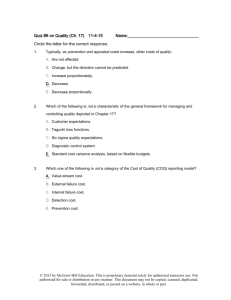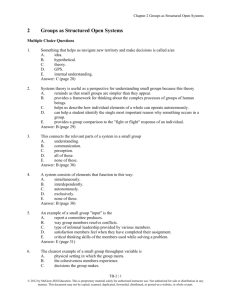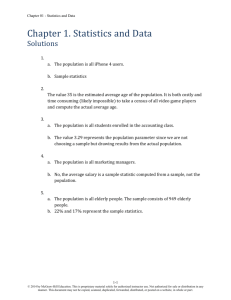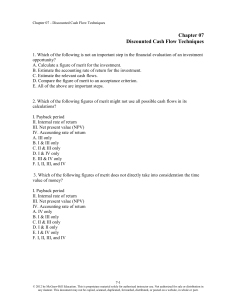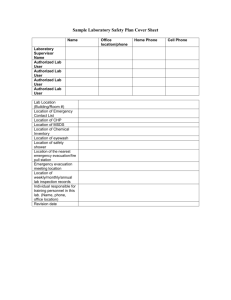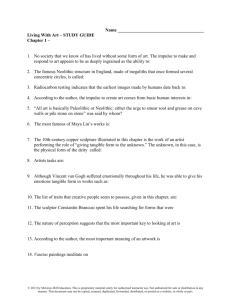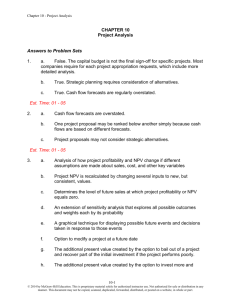FREE Sample Here - Find the cheapest test bank for your
advertisement
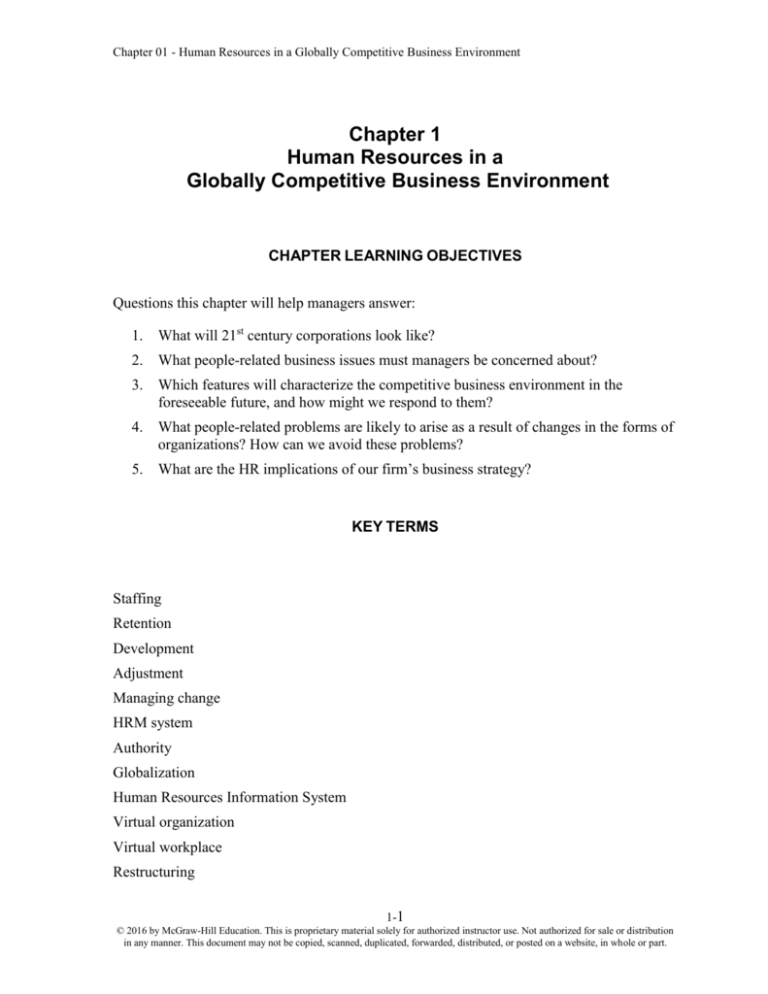
Chapter 01 - Human Resources in a Globally Competitive Business Environment Chapter 1 Human Resources in a Globally Competitive Business Environment CHAPTER LEARNING OBJECTIVES Questions this chapter will help managers answer: 1. What will 21st century corporations look like? 2. What people-related business issues must managers be concerned about? 3. Which features will characterize the competitive business environment in the foreseeable future, and how might we respond to them? 4. What people-related problems are likely to arise as a result of changes in the forms of organizations? How can we avoid these problems? 5. What are the HR implications of our firm’s business strategy? KEY TERMS Staffing Retention Development Adjustment Managing change HRM system Authority Globalization Human Resources Information System Virtual organization Virtual workplace Restructuring 1-1 © 2016 by McGraw-Hill Education. This is proprietary material solely for authorized instructor use. Not authorized for sale or distribution in any manner. This document may not be copied, scanned, duplicated, forwarded, distributed, or posted on a website, in whole or part. Chapter 01 - Human Resources in a Globally Competitive Business Environment Downsizing Six Sigma Ethical decisions about behavior Productivity Quality of Work Life CHAPTER 1 OUTLINE HUMAN RESOURCE MANAGEMENT IN ACTION: THE 21ST-CENTURY CORPORATION ● New technologies and the Internet are fueling radical transforms of corporations. It is nothing less than a new Industrial Revolution. ● Corporations must: ✓ Adapt themselves to management via the Web ✓ Base structure on constant change, not rigid hierarchies. ✓ Build on shifting partnerships and alliances, not self-sufficiency. ✓ Be constructed on technological advantages, not bricks and mortar. ● Modern organization charts look more like Webs than a pyramid. ● Companies of the future will turn customers into partners, giving them the technology to design and demand exactly what they want. ● Intellectual capital will be critical to business success, and organizations will need a deep talent pool and the kinds of cultures and reward systems to keep the best minds engaged. ● It’s Global: The company of the future will call on talent and resources, especially intellectual capital, wherever they can be found. ● It’s About Speed: If companies are to thrive in a hyper-competitive environment, they must innovate more and faster. 1-2 © 2016 by McGraw-Hill Education. This is proprietary material solely for authorized instructor use. Not authorized for sale or distribution in any manner. This document may not be copied, scanned, duplicated, forwarded, distributed, or posted on a website, in whole or part. Chapter 01 - Human Resources in a Globally Competitive Business Environment Challenge Questions 1. In Table 1-1, which dimensions of the 21st-century prototype model require effective skills in managing people? All the dimensions require effective people management skills. However, if one were to select five from this grouping that require particularly high skills in managing people, they would be: a) inspirational leadership, b) working in teams, c) working among cultural diversity, d) managing structural interdependencies, and e) focusing on customers (internal and external). 2. How might the Internet change the ways that employees and managers interact? Face-to-face communication will decrease, and there will be more reliance on electronic communication (email, voicemail, video conferencing, skype, facetime, etc.). The flow of information will increase and it will be more current, which will facilitate decision-making. However, the increase in information can lead to information overload, and employees and managers alike can struggle with job scope. The Internet will link corporations or business units around the globe, which will make it easier for employees, freelancers, and suppliers to work together. 3. If the 21st-century prototype model of organizations is to be successful, how must companies change their approach to managing people? Each organization must find its own unique solution to the problem of how best to manage people in their particular context. Generally, organizations will consist of fewer but more highly skilled, flexible, and team-oriented workers. Clearly, changes in selection, training, evaluation, and reward systems are necessary for these selfdirected knowledge workers compared to their predecessors. Selection on the basis of fit with company culture, training in teamwork skills, evaluation based on accomplishment of team goals, and rewards based on knowledge acquired are all examples of possible changes. What work “looks” like will change. All employees will not be at desks and workstations. Managers will need to learn to measure productivity in new ways. THE ENTERPRISE IS THE PEOPLE ● Organizations are managed and staffed by people. ● Without people, organizations cannot exist. ● Managing people is the most vital of all resources in work settings. ● The differences among people must be managed in a way that maximizes each person’s potential and effectiveness. 1-3 © 2016 by McGraw-Hill Education. This is proprietary material solely for authorized instructor use. Not authorized for sale or distribution in any manner. This document may not be copied, scanned, duplicated, forwarded, distributed, or posted on a website, in whole or part. Chapter 01 - Human Resources in a Globally Competitive Business Environment MANAGING PEOPLE: A CRITICAL ROLE FOR EVERY MANAGER ● Managers must be concerned with five activities: ✓ Staffing ✓ Retention ✓ Development ✓ Adjustment ✓ Managing change ● Staffing comprises the activities of: ✓ Identifying work requirements within an organization. ✓ Determining the numbers of people and the skills mix necessary to do the work. ✓ Recruiting, selecting, and promoting qualified candidates. ● Retention comprises the activities of: ✓ Rewarding employees for performing their jobs effectively. ✓ Ensuring harmonious working relations between employees and managers. ✓ Maintaining a safe, healthy work environment. ● Development is a function whose objective is to preserve and enhance employees’ competence by improving their knowledge, skills, abilities, and other characteristics. ● Adjustment comprises activities intended to maintain compliance with the organization’s HR policies and business strategies ● Managing change is an ongoing process whose objective is to enhance the ability of an organization to anticipate and respond to developments in its external and internal environments, and to enable employees at all levels to cope with the changes. ● Together, these activities constitute the HRM system. ✓ A single event, such as an unexpectedly large number of early retirees, can affect the whole system because all parts of the system, such as staffing, training, compensation, and labor relations, are interrelated. ✓ The HRM system should be linked with larger organizational needs. ✓ Staffing, retention, development, and adjustment lie not only with the HR department, but with every manager; managers have organizational authority to influence the actions and behavior of the workers they manage. 1-4 © 2016 by McGraw-Hill Education. This is proprietary material solely for authorized instructor use. Not authorized for sale or distribution in any manner. This document may not be copied, scanned, duplicated, forwarded, distributed, or posted on a website, in whole or part. Chapter 01 - Human Resources in a Globally Competitive Business Environment Why Does Effective HRM Matter? ● There is a strong connection between how firms manage their people and the economic results they achieve. ● Adoption of high-performance work practices can have an economically significant effect on the market value of a firm. ● HR systems have important, practical impacts on the survival and financial performance of firms, and on the productivity and quality of work life of the people in them. FEATURES OF THE COMPETITIVE BUSINESS ENVIRONMENT Globalization ● Globalization of a business refers to the free movement of capital, goods, services, ideas, information, and people across national boundaries. ● There is a growing fear that globalization benefits big companies instead of average citizens, which is creating a backlash against globalization. Countries, companies, and workers are interconnected in ways they have never been before. Global trade affects everyone, no matter how small. Globalization is fueling mobility, and more people consider foreign posts as a part of their professional development. This will result in global competition for talent, requiring companies to brand themselves as employers of choice.Technology ● Technology is changing the way we live and work. ● The information revolution will transform everything it touches—and it will touch everything. ● Technology-driven job destruction does not decrease overall unemployment. Ultimately the economic growth created by new jobs overwhelms the drag from jobs destroyed. ● In this new, creative economy, the most important asset is the intellectual capital that resides in people. ● There can be no true ownership of people, which is why corporations must create an environment that makes the best people want to stay. ● Collaborative technology needs to be a key component of the firm’s global hiring strategy. Social networking sites can be used based on appropriate markets. ● The most central use of technology is an organization’s human resources information system (HRIS), which handles such things as benefits enrollment, applicant tracking, time and attendance records, training and development, payroll, pension plans, and employee surveys. 1-5 © 2016 by McGraw-Hill Education. This is proprietary material solely for authorized instructor use. Not authorized for sale or distribution in any manner. This document may not be copied, scanned, duplicated, forwarded, distributed, or posted on a website, in whole or part. Chapter 01 - Human Resources in a Globally Competitive Business Environment ● In a sense, the HRIS is a tool that facilitates management control and decision making. Demographic Changes and Increasing Cultural Diversity ● Diversity will become an increasingly important factor for HR managers. ● These trends have two key implications for managers: ✓ The reduced supply of workers will make finding and keeping employees a top priority. ✓ The task of managing a culturally diverse workforce, of harnessing the motivation and efforts of a wide variety of workers, will present a continuing challenge to management. RESPONSES OF FIRMS TO THE NEW COMPETITIVE REALITIES ● The “three-C” logic (command, control, compartmentalized information) that shaped organizational structures in the 19th and 20th century is no longer working. ● Trends accelerating the shift toward new forms of organization for the 21st century include: ✓ The shift from vertically integrated hierarchies to networks of specialists ✓ The decline of routine work, coupled with the expansion of complex jobs that require flexibility, creativity, and the ability to work well with people ✓ Pay tied less to a person’s position or tenure in an organization and more to the market value of his/her skills ✓ A change in the paradigm of doing business from making a product to providing a service, often by part-time or temporary employees ✓ Outsourcing of activities that are not core competencies of a firm ✓ The redefinition of work itself: constant learning, more higher-order thinking, less nine-to-five mentality ● Many firms are doing one or more of the following: ✓ Developing new forms of organization ✓ Restructuring, including downsizing ✓ Adopting quality-management programs ✓ Building flexibility into work schedules and rules New Forms of Organization ● A virtual organization consists of teams of specialists who come together to work on a project and then disband when the project is finished. 1-6 © 2016 by McGraw-Hill Education. This is proprietary material solely for authorized instructor use. Not authorized for sale or distribution in any manner. This document may not be copied, scanned, duplicated, forwarded, distributed, or posted on a website, in whole or part. Chapter 01 - Human Resources in a Globally Competitive Business Environment ● A virtual workplace is a place in which employees operate remotely from each other and from managers; they work anytime and anywhere. ● In a modular corporation, the basic idea to focus on a few core competencies and to outsource everything else to a network of suppliers. Such companies work best when they accomplish two objectives: ✓ Collaborating smoothly with suppliers ✓ Choosing the right specialty Restructuring, Including Downsizing ● Restructuring can be accomplished by: ✓ Selling or buying plants or lines of business ✓ Laying-off employees ● Downsizing is the planned elimination of positions or jobs and is the most common form of restructuring. ● Study: In terms of profitability, all categories of downsizers generate lower returns on assets than either stable employers or upsizers in the year prior to the announcement of the layoffs, in the year in which the layoffs occurred, and in the two subsequent years. ✓ The message to employers is clear: Don’t try to shrink your way to prosperity. The best way to prosper is by growing your business. Quality-Management Programs ● Six Sigma is an effort to make error-free products 99.9997 percent of the time, or just 3.4 defects per million opportunities. ● It is based on five steps: define, measure, analyze, improve, and control. ● Six Sigma’s main value to corporations today lies in its ability to save time and money. ● It generally takes three to five years before quality-management programs become institutionalized. ● Organizations known for the quality of their products and services strongly believe that employees are key to those results. 1-7 © 2016 by McGraw-Hill Education. This is proprietary material solely for authorized instructor use. Not authorized for sale or distribution in any manner. This document may not be copied, scanned, duplicated, forwarded, distributed, or posted on a website, in whole or part. Chapter 01 - Human Resources in a Globally Competitive Business Environment Flexibility ● Time is employees’ most precious commodity. They want the flexibility to control where, when, and how they work. ● Flexibility in schedules is the key to retaining talented workers. ● Flexibility is frequently viewed by managers and employees as an employee accommodation, rather than as a new and effective way of working to achieve business results. ● A face-time culture, excessive workload, manager skepticism, customer demands, and fear of negative career consequences are barriers that prevent employees from taking advantage of policies they might otherwise use—and that prevent companies from realizing the full benefits that flexibility might bestow. ● Three keys to making the business case for increased flexibility: talent management; human capital outcomes; and financial, operational, and business outcomes. PRODUCTIVITY: WHAT IS IT AND WHY IS IT IMPORTANT? ● Productivity is a measure of the output of goods and services relative to the input of labor, capital, and equipment. ● Nations vary significantly in terms of productivity, expressed as gross domestic product per person employed. Multifactor productivity is a measure of how businesses enhance production by combining workers and machines using technology, production processes, and managerial practices. ● Improving productivity is not working harder; it is working smarter. ● Today’s world demands that we do more with less—fewer people, less money, less time, less space, and fewer resources in general. ● Greater productivity benefits organizations directly (i.e., it improves their competitive position relative to that of rivals), and it benefits workers indirectly (e.g., in higher pay and improved purchasing power). ● Many workers want to see a tighter connection between working smarter and the tangible and psychological rewards they receive from doing their jobs well. 1-8 © 2016 by McGraw-Hill Education. This is proprietary material solely for authorized instructor use. Not authorized for sale or distribution in any manner. This document may not be copied, scanned, duplicated, forwarded, distributed, or posted on a website, in whole or part. Chapter 01 - Human Resources in a Globally Competitive Business Environment QUALITY OF WORK LIFE: WHAT IS IT? ● There are two ways of looking at what quality of work life (QWL) means: ✓ QWL equates with a set of objective organizational conditions and practices (e.g., promotion-from-within policies, democratic supervision, employee involvement, safe working conditions). ✓ QWL equates with employees’ perceptions that they are safe, relatively well satisfied, have reasonable work-life balance, and able to grow and develop as human beings. This relates QWL to the degree to which the full range of human needs is met. ● In theory, QWL is simple. It involves giving workers the opportunity to make decisions about their jobs, the design of their workplaces, and what they need to make products or to deliver services most effectively. ● Innovation, flexibility, individualism, flat organizational structures, and challenging roles for all are hallmarks of the new, creative economy. Fail often, fail well. It is about learning from failure. QWL REQUIRES A WILLINGNESS TO SHARE POWER, EXTENSIVE TRAINING FOR WORKERS AND MANAGERS, AND CONTINUOUS EXPERIMENTATION WITH NEW IDEAS. BUSINESS TRENDS AND HR COMPETENCIES ● Over the past decade, organizations have become more complex, dynamic, and fast-paced. ● Effective HR competencies: 1. Human Resource Expertise – The ability to apply the principles and practices of human resource management to contribute to the success of the business. 2. Relationship Management – The ability to manage interactions to provide service and to support the organization. 3. Consultation – The ability to provide guidance to organizational stakeholders. 4. Leadership and Navigation – The ability to direct and contribute to initiatives and processes within the organization. 5. Communication – The ability to effectively exchange with stakeholders. 6. Diversity and Inclusion – The ability to value and consider the perspectives and backgrounds of all parties. 7. Ethical Practice – The ability to support and uphold the values of the organization while mitigating risk. 8. Critical Evaluation – the ability to interpret information to make business decisions and recommendations. 9. Business Acumen – The ability to understand and apply information to contribute to the organization’s strategic plan. 1-9 © 2016 by McGraw-Hill Education. This is proprietary material solely for authorized instructor use. Not authorized for sale or distribution in any manner. This document may not be copied, scanned, duplicated, forwarded, distributed, or posted on a website, in whole or part. Chapter 01 - Human Resources in a Globally Competitive Business Environment THE 21ST CENTURY CORPORATION ● Management systems that produce profits through people share seven dimensions: 1. Employment security 2. Selective hiring 3. Self-managed teams and decentralization are basic elements of the organization design 4. Comparatively high compensation contingent on organizational performance 5. Extensive training 6. Reduced differences in status 7. Sharing of information ● Management is a human art and getting more so as information technology takes over routine tasks. SUMMARY ● People are a major component of any business, and the management of people is a major part of every manager’s job. It is also the specialized responsibility of the HR department. ● HRM involves five major areas: staffing, retention, development, adjustment, and managing change. ● The HRM function is responsible for maximizing productivity, quality of work life, and profits. ● The competitive business environment of the 21st century reflects factors such as an aging and changing workforce in a high-tech workplace. ● New organization forms, such as the virtual corporation, the virtual workplace, and the modular corporation, are appearing. Collaborative technology needs to be a key component of the firm’s global hiring strategy. ● Firms are restructuring, reengineering, implementing quality-improvement programs, and building flexibility into work schedules in order to support their competitive strategies. ● What work looks like will continues to change. Managers will need to learn to measure productivity in new ways. ● The challenge of attracting, retaining, and motivating people has never been greater. ● QWL refers to employees’ perceptions of their physical and psychological wellbeing at work. 1-10 © 2016 by McGraw-Hill Education. This is proprietary material solely for authorized instructor use. Not authorized for sale or distribution in any manner. This document may not be copied, scanned, duplicated, forwarded, distributed, or posted on a website, in whole or part. Chapter 01 - Human Resources in a Globally Competitive Business Environment ● HR professionals can help by serving as credible activists, cultural stewards, talent managers, strategy architects, business allies, and operational executors. ● Countries, companies, and workers are interconnected in ways they have never been before. ANSWERS TO DISCUSSION QUESTIONS 1-1. What are the HRM implications of globalization, technology, and e-commerce? As every economy becomes global, a nation’s most important asset becomes the skills and cumulative learning of its workforce. Capital, technology, raw materials, and information are all interchangeable, the workforce is not. Therefore, globalization will increase the need for HR professionals to attract, train, retain, and motivate the workforce. The most central use of technology is an organization’s human resources information system (HRIS), which is replacing labor-intensive, manual HR activities. For instance, many applicant tracking, time and attendance records, payroll, and pension plans are now automated. This allows for faster response times and report generation. In a sense, today’s HRIS tools facilitate management control and decision making. E-commerce and the Internet are the foundation for a new industrial order and will empower consumers like nothing else ever has. They will fundamentally change customer’s expectations about convenience, speed, comparability, price, and service. The people who make e-commerce possible are highly skilled knowledge workers; HR’s challenge will be to attract, retain, and motivate them to perform well. 12. How will demographic changes and increasing diversity in the workplace affect the ways that organizations manage their people? Employers are facing a chronic shortage of skilled help. The mix as well as the numbers of people available to work is changing rapidly. These trends have two key implications for managers: 1) the reduced supply of workers will make finding and keeping employees a top priority and 2) the task of managing a culturally diverse workforce, of harnessing the motivation and efforts of a wide variety of workers, will present a continuing challenge to management. The organizations that thrive will be the ones that embrace the new demographic trends instead of fighting them. Workforce diversity is not just a competitive advantage; it is a competitive necessity. 1-11 © 2016 by McGraw-Hill Education. This is proprietary material solely for authorized instructor use. Not authorized for sale or distribution in any manner. This document may not be copied, scanned, duplicated, forwarded, distributed, or posted on a website, in whole or part. Chapter 01 - Human Resources in a Globally Competitive Business Environment 1-3. Considering everything we have discussed in this chapter, describe management styles and practices that will be effective for your country’s businesses in the next decade. Effective management styles for the next decade will include global awareness, cultural sensitivity, environmentally responsible resource use, and a heavy emphasis on training and development both to compensate for employee skill shortages and to develop competitive advantage. There will be a strong emphasis on quality, customer satisfaction, and productivity growth. The latter will be obtained through employee involvement programs and enhanced teamwork. Managers will be leaders and coaches, rather than bosses and autocrats. 14. What difficulties do you see in shifting from a hierarchical, departmentalized organization to a leaner, flatter one in which power is shared between workers and managers? Reengineering business processes requires that managers create an environment and organizational culture that embraces changes. The effectiveness of such efforts depends on effective leadership and communication—both of which are peoplerelated business processes. As with all people-related activities, this will be hard to accomplish. Additionally, a flatter organization requires a fundamental shift in manager-employee relations. Managers must learn to share power with workers and understand their new role as leaders, helpers, and information gatherers, rather than controllers and directors. Workers must be trained to understand business practices and to gain management and decision-making skills. 15. How can effective HRM contribute to improvements in productivity and quality of work life? HR professionals play six key roles to improve productivity and quality of work life. Credible activists deliver results with integrity, share information, build relationships of trust, take appropriate risks, provide candid observations, and influence others. They are admired and listened to, take positions, and challenge assumptions. This is the heart of what it takes to be an effective HR leader. Cultural stewards recognize, articulate, and help shape company culture by facilitating change, helping employees find meaning in their work, managing work-life effectiveness, and encouraging innovation. Talent managers/organizational designers ensure today’s and tomorrow’s talent, shape the organization, foster communication, and design reward systems. They do this by mastering theory, research, and practice in these areas. Strategy architects know how to make the right changes happen. They execute changes in strategy, and energize others to accept and embrace the changes. Business allies contribute to success by knowing how their businesses make money, who the customers are, and why customers buy the company’s products and services. They are 1-12 © 2016 by McGraw-Hill Education. This is proprietary material solely for authorized instructor use. Not authorized for sale or distribution in any manner. This document may not be copied, scanned, duplicated, forwarded, distributed, or posted on a website, in whole or part. Chapter 01 - Human Resources in a Globally Competitive Business Environment 16. 17. 18. 19. 20. “business literate,” for they understand the business and how it works, the financials, and the strategic issues. Operational executors administer the day-to-day work of managing people by implementing workplace policies and advancing HR technology. How can effective HRM contribute to sustainability? The HRM function also has the potential to contribute important skills in areas such as change management and cultural stewardship. Embedding a sustainability strategy deeply into an organization’s culture and management practices is an ongoing challenge. Practices such as values-based recruitment using employer branding informed by sustainability initiatives, helping employees and managers link performance targets to sustainability initiatives, and linking variable pay to those initiatives, accomplish two objectives. They support the broader business approach to sustainability and they create and deliver core HRM processes sustainably. If you could only work on three of the nine key HR competencies, what would they be and why did you choose those three? Personal reflection question. New technology sometimes destroys old jobs, but it also creates new ones. What recommendations would you make to high-level policy makers in organizations and government to address this issue? Personal reflection question. It has often been said that people don’t leave bad companies; they leave bad bosses. What can managers do to enhance employee retention? Three features are key, talent management (specifically, attraction and retention); human capital outcomes (increased satisfaction and commitment, decreased stress); and financial, operational, and business outcomes. How does the effective management of people provide a competitive advantage to organizations? People make organizations go. How the people are selected, trained, and managed determines to a large extent how successful an organization will be. As you can certainly appreciate by now, the task of managing people in today’s world of work is particularly challenging in light of the competitive realities we have discussed. To colleagues at functions, CASE 1-1: PEPSICO’S INDRA NOOYI: PERFORMANCE WITH A PURPOSE Case Questions: 1. One measure used to assess competitive advantage is shareholder value creation. When comparing Coca-Cola and Pepsico along this dimensions, one might conclude that Pepsico, under Ms. Nooyi’s leadershiop, has sustained a competitive disadvantage, relative to Coca-Cola. Do you agree with this assessment? Why or why not? 2. If you were to apply a triple-bottom-line approach to assessing competitive advantage, would you reach a different conclusion? Why or why not? 3. If you were a board member at Pepsico, would you be concerned? Why or why not? If you were concerned, what actions would you recommend? 1-13 © 2016 by McGraw-Hill Education. This is proprietary material solely for authorized instructor use. Not authorized for sale or distribution in any manner. This document may not be copied, scanned, duplicated, forwarded, distributed, or posted on a website, in whole or part. Chapter 01 - Human Resources in a Globally Competitive Business Environment 1-14 © 2016 by McGraw-Hill Education. This is proprietary material solely for authorized instructor use. Not authorized for sale or distribution in any manner. This document may not be copied, scanned, duplicated, forwarded, distributed, or posted on a website, in whole or part.
